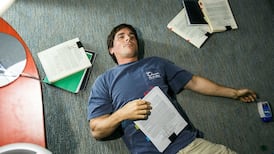STAVE and chime, rush and shook and heading knife: words from a lexicon familiar to the faded legions of Irish coopers, now represented at Midleton Distillery by Master Cooper Ger Buckley. This archaic vocabulary seems vastly distant from such events as the death on hunger strike of Terence MacSwiney in 1920, or from the paddocks of the Dunne family home at Ringmahon House near Blackrock in Cork. Yet nothing is unlikely when it comes to dynastic genealogy, and supermarket proprietors and a martyred lord mayor can be gathered now to the branches of an industrial family tree at Midleton.
The cooperage at the Old Distillery is not on the usual tourist trail of the Jameson Experience at Midleton. It houses just one element of the €400,000 archival commitment being initiated by Irish Distillers Pernod Ricard, which will collect, catalogue and locate in one custom-designed place at the Old Distillery all the records from the dawn of the company formed under its present title in 1988.
Revelations as well as facts can be expected from an estimated 3,000 boxes of material relating the progress and the personalities of several business enterprises brought together through the merging in 1966 of the Dublin firms of John Jameson and Son and John Power and Son with the Cork Distilleries Company.
The Cork company was itself an amalgamation of earlier distilleries united under the partnership of James, John and Nicholas Murphy trading as James Murphy and Co. Originating in tanning and shoemaking, the local Murphy grouping absorbed the Cork distilling firms of Wise, Hackett, Daly, Waters and Hewitt during the 19th century after James Murphy established his distillery in Midleton in 1825. The Murphys were prolific, with families of 14 or 15 children spreading through the glades of Montenotte and Blackrock and numbering bishops, archdeacons, MPs, high sheriffs and a papal count among the clan. Brewing was their other concern, with brothers James J and William taking off in 1857 to establish the Lady’s Well Brewery in Blackpool (now Heineken Ireland).
The James Murphy (1769-1855) who built Ringmahon House went into partnership with his brother Nicholas in the shipping and import trade before diversifying into distilling. He had taken a 21-year lease of Ringmahon from the brewer William Crawford; his most famous ship was the Ringmahon Castle, a brig built in Cork in 1825 and renowned for its speed. The house itself stayed with the Murphys until the last James Murphy died in 1948; it seems appropriate that its later residents should themselves embody one of Ireland's most notable entrepreneurial families and one which has funded its recent meticulous restoration by Cork City Council.
Among the thronged pages of this story is Muriel Murphy, daughter of Nicholas and later famously the widow of Terence MacSwiney, the lord mayor of Cork who died on hunger strike in England in 1920. Her family, already suspicious of Muriel’s unconventional notions of social justice and artistic engagement, disapproved of this marriage and the wedding was delayed until her 25th birthday brought financial independence. However, it also brought her to her husband’s life of sacrifice and imprisonment which was to end only with his death in Brixton Jail.
Archive director Stephen Franck will have his work cut out over the next two years to distinguish between the numerous James and Nicholases: there's the Nicholas of Lauriston, his cousin Nicholas of Clifton and his son Nicholas of Carrigmore. But there will be high points, not least the possibility of discovering a genealogical link between these Murphy brothers and cousins descended from a shoemaker and a tanner and Marie-Louise Murphy, La Morfi,daughter of an émigré Cork cobbler, mistress, for a time, of Louis XV of France, enshrined by Boucher among the Holy Family in the queen's chapel at Versailles and the bare-bottomed subject of one of that artist's most voluptuous paintings, Ruhendes Mädchen(1752).
But even if that’s a bit far-fetched, Stephen Franck already has items such as the notebook of apprentice William Caldwell dated from the Cork distillery at Millfield in 1798. The pages offer recipes for gin, for “Brandy, best sort”, for wormwood waters, spirits of wine, for shrub and cherry brandy. “Our material is lodged in different places”, explains Franck.
“It includes worker and wages details for the different companies, letters, documents, artefacts and oral history. Ultimately we hope to reunite all these records here in a properly conditioned environment with professional staff. Essentially we’re building an archive which will become an important national resource for social and economic history in Ireland and when it has been catalogued it will also be provided online.”
Language is part of that record; language and custom: “coopers always kept their hands in their pockets on public occasions”, says Ger Buckley, whose hands are not in his pockets. That’s because his coopering skills are now for demonstrations only, but as he shows the hammer, its head or handle worn by degrees comprehensible to the men of the craft; or the heading knife which gets a chamfer on the head of a stave; or the jointer to achieve a bevel, it is clear that hands worn by work of this kind could rarely be objects of
beauty.
Yet what those hands produced were marvels of graceful function, the geometry of their composition a hidden wonder.









